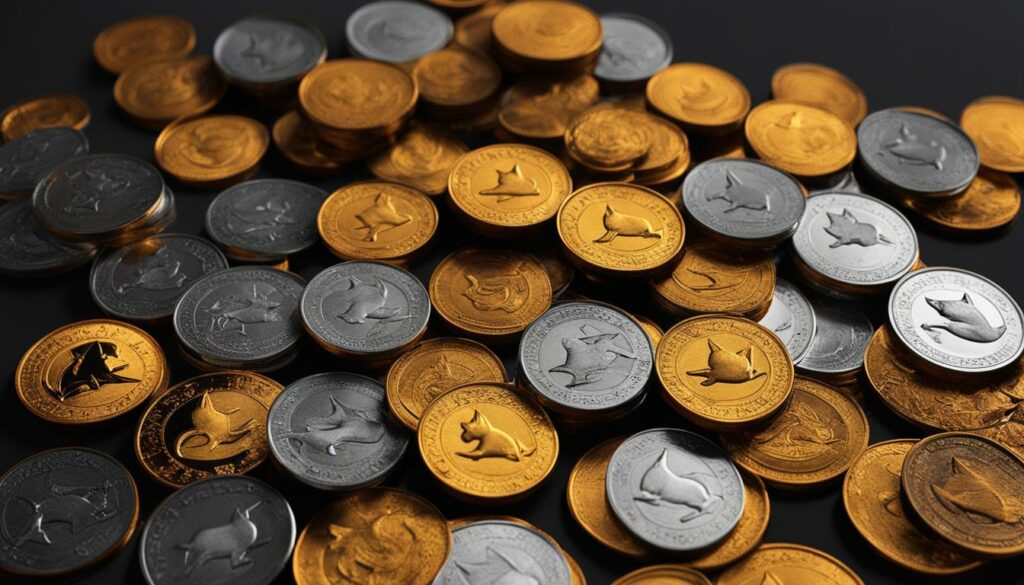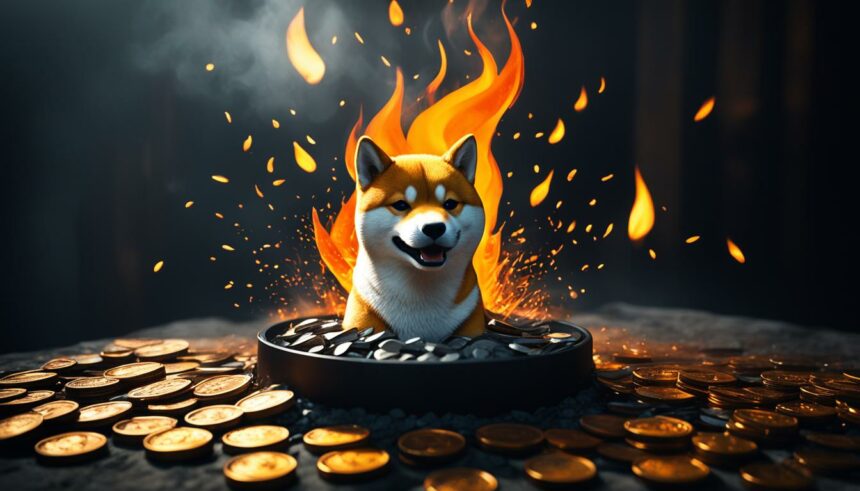If you’re an investor in the world of cryptocurrency, you may be familiar with the term ‘burn rate.’ Burn rate refers to the gradual reduction of the token supply over time. The Shiba Inu token is no exception, with its unique deflationary mechanism designed to reduce token circulation. The Shiba Inu coin burn rate heavily influences the tokenomics of the project and is a crucial factor to consider in investing decisions.
Key Takeaways:
- The Shiba Inu coin burn rate influences the token supply and overall deflationary mechanism of the project.
- The burning mechanism is designed to reduce token circulation and potentially impact the token’s value and market dynamics.
- Understanding the dynamics of the Shiba Inu coin burn rate is essential for investors and enthusiasts alike.
- The burn rate is impacted by factors such as transaction volume, token holders’ behavior, and project milestones.
- Shiba Inu’s deflationary mechanism makes it an attractive investment opportunity.
Understanding Shiba Inu Tokenomics
Shiba Inu, like many other cryptocurrencies, operates on a deflationary model. This means that the Shiba Inu token supply decreases over time, making the tokens more valuable. The initial coin supply for Shiba Inu was one quadrillion tokens, with 50% of the total supply locked to Uniswap and another 50% burned.
Unlike other cryptocurrencies that rely on transaction fees to incentivize miners, Shiba Inu uses a coin burn rate to push up the value of the token.When a user makes a transaction using Shiba Inu, a small percentage of the tokens is burned, reducing the overall supply and driving up the value of the remaining tokens.
The Shiba Inu coin burn rate also has implications for investors, as it can impact the token’s value and market dynamics. As the supply of Shiba Inu decreases over time, the token may become scarcer, which could increase its value.
One potential drawback of a deflationary model is that the token may become too expensive for some users to transact with, which could reduce demand and consequently lead to lower prices. Additionally, the high value of the Shiba Inu coin may make it an attractive target for hackers and scammers.
Exploring the Shiba Inu Coin Burning Mechanism
Shiba Inu’s unique burning mechanism is at the core of its deflationary tokenomics. When transactions occur on the network, a portion of each transaction is taken out of circulation and burned forever. This creates a scarcity of Shiba Inu tokens, driving up their value over time, as per the law of supply and demand. The burning mechanism starts with a total fixed supply of 1 quadrillion Shiba Inu tokens, and with each transaction, a certain amount of tokens are burned. This means that over time, the supply of Shiba Inu tokens decreases while the value has the potential to increase.
Several factors influence the burn rate of Shiba Inu tokens. One primary factor is the transaction volume on the network, as the more transactions there are, the more tokens will be burned. Additionally, the number of holders on the network affects the burn rate, as there will be more transactions, and therefore more burns. Another factor that could affect the burn rate is the price of the token itself.
By analyzing the historical data of Shiba Inu coin burning, we can gain insights into the burn rate and its variations over time. According to data from Etherscan, the current total burn is approximately 394 trillion tokens, accounting for around 39% of the initial token supply. The daily burn rate varies based on network activity, but on average, roughly 2 billion tokens are burned per day.

The burning mechanism has several implications for investors and token holders. As the supply of Shiba Inu tokens decreases over time, assuming demand remains constant or grows, the value of the token may increase. However, this effect can also be magnified if there is increased demand for Shiba Inu, causing a scarcity of tokens. Ultimately, the Shiba Inu burning mechanism is an integral part of the project’s deflationary tokenomics and will continue to affect its market dynamics moving forward.
Impact of the Shiba Inu Coin Burn Rate on Tokenomics
Shiba Inu’s unique deflationary mechanism, which relies on its coin burn rate, has a significant impact on the tokenomics of the project. By reducing the total token supply through burning, Shiba Inu aims to create scarcity and increase the value of the remaining tokens. This has several effects on the market dynamics of Shiba Inu.
Firstly, the burning of coins creates a sense of scarcity, which can attract more investors who are looking to cash in on potential price appreciation. This can potentially increase demand for the token and drive up its value.
Additionally, the deflationary mechanism can lead to long-term price stability, as the reducing supply of Shiba Inu tokens can prevent sudden or excessive price fluctuations. Moreover, investors who believe in the long-term potential of Shiba Inu may hold onto their tokens, further reducing the available supply.
However, the deflationary mechanism also presents some challenges. It can potentially create a disincentive for spending or using Shiba Inu tokens, as the perception of scarcity can lead to hoarding. This can affect the network’s overall adoption and use case. Additionally, a significant burn rate could lead to a significant reduction in the token’s supply, which can affect its liquidity and trading volume.
Overall, the impact of the Shiba Inu coin burn rate on tokenomics can be significant, as it influences the market dynamics, value, and investor sentiment. The deflationary mechanism has its advantages and challenges, which investors must take into consideration when determining their investment strategy for Shiba Inu.
Analyzing the Dynamics of Shiba Inu Coin Burn Rate
In the previous section, we discussed the various factors that contribute to the Shiba Inu coin burn rate. In this section, we will take a deeper dive into these dynamics and their impact on the overall deflationary mechanism.
Transaction Volume
The Shiba Inu coin burn rate is heavily influenced by the transaction volume on the network. As the demand for Shiba Inu increases, more transactions occur, thereby increasing the overall burn rate. On the other hand, decreased transaction volume can lead to a lower burn rate.
It’s important to note that the transaction volume is not solely affected by investor demand. Other factors, such as network congestion and gas fees, can also have a significant impact on transaction volume and consequently, the coin burn rate.
Token Holders’ Behavior
The behavior of Shiba Inu token holders can also impact the coin burn rate. For instance, if more holders decide to burn their tokens, the burn rate will increase. Similarly, if more holders decide to sell their tokens, the burn rate will decrease.
Therefore, it’s essential to keep an eye on token holder behavior and sentiment, as they can significantly impact the performance of the Shiba Inu token.
Project Milestones
The launch of new project milestones or partnerships can also have an impact on the Shiba Inu coin burn rate. Positive developments such as these can increase investor demand and transaction volume, thereby leading to a higher burn rate. Similarly, negative news can lead to decreased demand and a lower burn rate.
Implications on Supply and Deflationary Mechanism
The dynamics we discussed above have significant implications for the overall deflationary mechanism of the Shiba Inu token. As the burn rate changes due to various factors, it impacts the rate at which tokens are taken out of circulation. This, in turn, leads to changes in the overall token supply.
As we discussed previously, a decreasing token supply can lead to increased token value due to the principles of supply and demand. Therefore, understanding the dynamics of the Shiba Inu coin burn rate is crucial to understanding the potential value of the token.
“The Shiba Inu coin burn rate is a complex and dynamic mechanism that plays a crucial role in the overall tokenomics of the project. By understanding the various factors that contribute to the burn rate, investors can make better-informed decisions regarding the potential value and performance of the Shiba Inu token.”
Conclusion
In conclusion, the Shiba Inu coin burn rate is a unique feature of this popular cryptocurrency that sets it apart from other digital assets. As we explored in this article, understanding the underlying dynamics of the Shiba Inu tokenomics and deflationary mechanism is crucial for investors and enthusiasts alike to make informed decisions.
The burning mechanism helps maintain a deflationary environment in the Shiba Inu ecosystem, which can potentially impact the token’s value and market dynamics. Therefore, keeping track of the coin burn rate and its variations over time is essential to assess the project’s health and sustainability.
Overall, Shiba Inu is an exciting cryptocurrency project that has garnered significant attention in the crypto community. Its unique tokenomics and deflationary mechanism make it an intriguing choice for investors looking for alternative investment opportunities. As always, it is crucial to do your research and understand the risks associated with investing in cryptocurrencies.
So, that’s all about Shiba Inu coin burn rate, Shiba Inu token, cryptocurrency burn rate, Shiba Inu coin supply, Shiba Inu tokenomics, and Shiba Inu deflationary mechanism in a nutshell. We hope you found this article informative and learned something new about this fascinating cryptocurrency project.
FAQ
What is the Shiba Inu coin burn rate?
The Shiba Inu coin burn rate refers to the process of removing a certain amount of Shiba Inu tokens from circulation and permanently destroying them. This burning mechanism helps create a deflationary environment, reducing the overall supply of Shiba Inu coins over time.
How does the Shiba Inu burning mechanism work?
The Shiba Inu burning mechanism works by allocating a portion of each transaction fee to be burned. For example, a percentage of each buy or sell transaction fee is set aside and the corresponding amount of tokens is permanently removed from circulation, effectively decreasing the total supply of Shiba Inu coins.
What is the impact of the Shiba Inu coin burn rate on tokenomics?
The Shiba Inu coin burn rate has significant implications for the tokenomics of the project. As tokens are burned, the overall supply of Shiba Inu coins decreases, creating a potential scarcity that may drive up the value of the remaining tokens. Additionally, the burning mechanism helps incentivize long-term holding and discourages excessive selling, contributing to price stability.
How does the Shiba Inu coin burn rate affect the market dynamics?
The Shiba Inu coin burn rate influences the market dynamics by reducing the supply of tokens. This can create a positive feedback loop, where a decreasing supply leads to increased demand, potentially driving up the token price. Moreover, the burning mechanism can generate investor confidence in the project’s long-term sustainability, attracting more participants to the ecosystem.
What factors determine the Shiba Inu coin burn rate?
The Shiba Inu coin burn rate is influenced by various factors, including the transaction volume on the network and the percentage allocated to the burning mechanism. The burn rate can also be affected by external factors such as project milestones, community engagement, and market conditions. It is important to note that the burn rate may vary over time based on these factors.
Why is understanding the dynamics of the Shiba Inu coin burn rate important?
Understanding the dynamics of the Shiba Inu coin burn rate is crucial for investors and enthusiasts as it provides insights into the tokenomics and potential market behavior. By analyzing the burn rate, one can gain a better understanding of the deflationary mechanism, evaluate the token’s supply and demand dynamics, and make more informed decisions regarding Shiba Inu.











